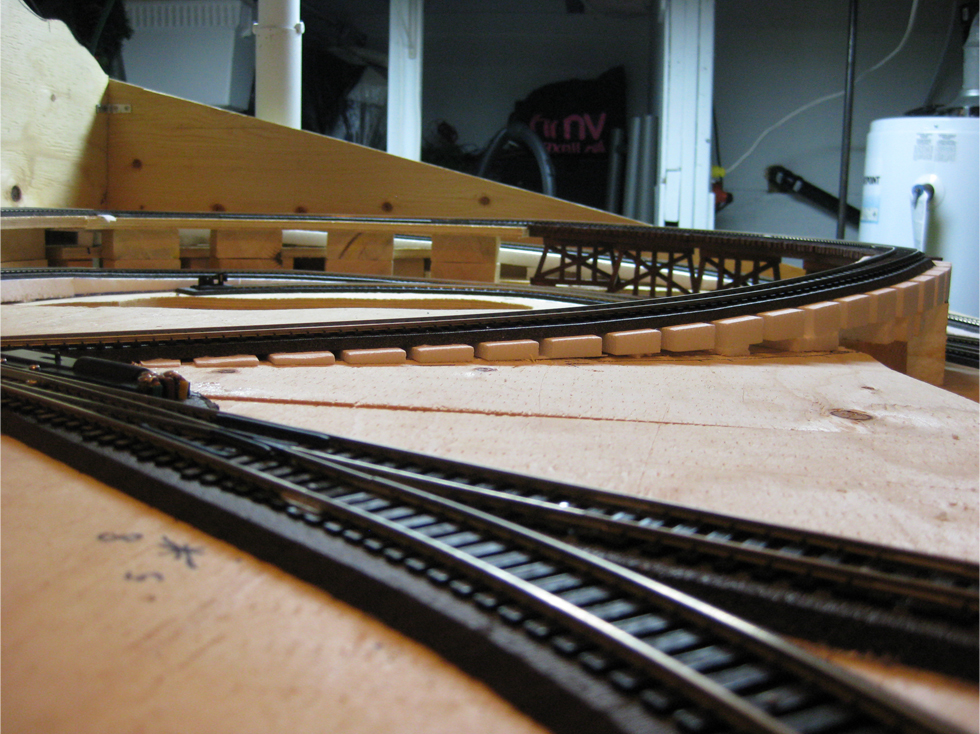As this is my first layout, almost every aspect of the construction of
model railroading is new to me. Most tasks are trial and error and the
amount I’m learning is extraordinary. At the same time, I’m also seeing
where I went wrong, and the biggest error so far is the grade leading off my
trestle down to the 60 degree crossing. This has been a huge issue since I
first designed the layout. Engines would get high centered at the top of the
hill and the engine's cattle guards would catch on the grade crossings,
always causing a derailment. This grade had to go, so back to the drawing
board I went. With a little better planning, I managed to take the grade
from almost 11%, down to just over 6%.
I removed the entire grade to start fresh. I took two things into account
when redesigning the grade. The first was that I needed to try to make the
distance from the 60 degree crossing to the end of the trestle longer.
Second, I had to decrease the height of the trestle. These two items were
essential in making a more successful grade.
To do this, I removed about 4 1/2" of the track structure leading up to the
trestle, thus allowing me to move the trestle further over to the right of
my layout. Second, I had to lower one end of the trestle. The trestle had
almost 3/4" clearance above passing trains, so with a few modifications I
lowered the trestle about 1/2” on one end. The trestle now has a down grade
of about 2%.
For the rest of the grade, I used a 4% foam starter grade from Woodland
Scenics. This allowed me to easily transition from the crossing level up to
the edge of the trestle. I then used custom cut foam shims to support the
new grade and to make it as smooth as possible. I added foam roadbed and one
continuous piece of flex track to ensure a continuously smooth track. The
end result was flawless. No more derailments and no more high centered
engines!
Calculating and Working With Grades
Most prototypical modelers will tell you to build nothing with a grade over
2%. For small layouts such as mine, this isn't always possible. This is
especially true if you want a layout with lots of visual interests such as
tunnels, bridges, mountains and curves. To calculate grade, use the
following formula:
(rise / run) x 100 = slope %
For example, say your track needs to go from point A at 0.5" elevation to
point B at 4.5" elevation, a height difference (rise) of 4", and you have a
200" distance (run) between point A and B. Take the rise and divide it by
the run (4 / 200). Now take that number and multiply it by 100 to get your
grade percentage, which is 2% for this example.
As you can see, you would need at least 200" (16.6 feet) to raise your
track 4" in elevation at a maximum grade of 2%! Unless you have a massive
layout, this just isn't possible without going above 2%. Most often, you
should be able to get away with grades up to 6% without many issues, though
these are no longer prototypical. Keep these points in mind when planning
your layout and grades:
- Plan first and know your limits. When designing your layout, try to give yourself as much room as possible. The more room you have to get from point A to point B, the lower the grade will be and the less headaches you will have. There are physical limits to how steep your train can travel, especially with rolling stock.
- Keep your grade as consistent as possible with smooth, gradual transitions at each end. This is almost more important than the grade itself. Transitions into and out of your grade that are too immediate will create sharp humps and valleys, resulting in engines getting high centered at the top and bottoming out at the bottom. The longer the locomotive, the more of an issue this will be. Sharp transitions can also cause rolling stock to uncouple.
- Grade crossings require level track leading up to them to prevent couplers and cattle guards from catching on them. If you have a road grade crossing on your track grade, make sure the grade is no more than 2% for at least 8” before the crossing.
- Experiment and test often as you build. Play around with different grades with actual track and engines before you make anything permanent. Allow for adjustments, and if it doesn’t work the first time, find what’s causing the issue and retry.
- Don’t let anyone ruin your fun. The 2% rule is the standard for prototypical models that mimic real life track grades, and even in real life there are exception to that rule. The Pennsylvania Railroad operated by Madison Railroad has a grade of 5.89%! Make a layout as you see fit, after all it’s your train and your imagination. Do what makes you happy and proud.






3 comments
I'm playing with grades myself on my first layout. Mine are about 6-7% I'm throwing in some switchbacks so it'll be interesting to see how it turns out. Enjoy the site and keep up the good work!
ReplyDeleteTN SSLC Important Questions Paper 2022 Download available in the Subjects of English, Tamil Medium All Subject Pdf will help the Students to get an Idea of the Public Exam Pattern and the Distribution of marks for each Topic, TN SSLC important Question Paper Students how are Appearing for the 10th Standard Public Exam Advised Going Through the Last Year Exam Question Paper. Solving These Tamil Nadu SSLC Question Bank 2022 will Boost their Confidence level as well as Teach them time Management.
ReplyDeleteAppreciate your blog postt
ReplyDelete